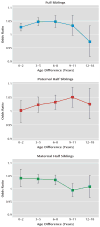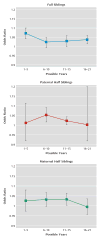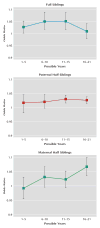Genetic and family and community environmental effects on drug abuse in adolescence: a Swedish national twin and sibling study
- PMID: 24077613
- PMCID: PMC3927993
- DOI: 10.1176/appi.ajp.2013.12101300
Genetic and family and community environmental effects on drug abuse in adolescence: a Swedish national twin and sibling study
Abstract
Objective: Using Swedish nationwide registry data, the authors investigated genetic and environmental risk factors in the etiology of drug abuse by twin sibling modeling. The authors followed up with epidemiological analyses to identify shared environmental influences on drug abuse.
Method: Drug abuse was defined using public medical, legal, or pharmacy records. Twin and sibling pairs were obtained from the national twin and genealogical registers. Information about sibling pair residence within the same household, small residential area, or municipality was obtained from Statistics Sweden. The authors predicted concordance for drug abuse by years of co-residence until the older sibling turned 21 and risk for future drug abuse in adolescents living with parental figures as a function of family-level socioeconomic status and neighborhood social deprivation.
Results: The best twin sibling fit model predicted substantial heritability for drug abuse in males (55%) and females (73%), with environmental factors shared by siblings operating only in males and accounting for 23% of the variance in liability. For each year of living in the same household, the probability of sibling concordance for drug abuse increased 2%-5%. When not residing in the same household, concordance was predicted from residence in the same small residential area or municipality. Risk for drug abuse was predicted both by family socioeconomic status and neighborhood social deprivation. Controlling for family socioeconomic status, each year of living in a high social deprivation neighborhood increased the risk for drug abuse by 2%.
Conclusions: Using objective registry data, the authors found that drug abuse is highly heritable. A substantial proportion of the shared environmental effect on drug abuse comes from community-wide rather than household-level influences. Genetic effects demonstrated in twin studies have led to molecular analyses to elucidate biological pathways. In a parallel manner, environmental effects can be followed up by epidemiological studies to clarify social mechanisms.
Conflict of interest statement
The authors report no financial relationships with commercial interests.
Figures




Comment in
-
Community, siblings, heritability and the risk for drug abuse.Am J Psychiatry. 2014 Feb;171(2):140-1. doi: 10.1176/appi.ajp.2013.13111508. Am J Psychiatry. 2014. PMID: 24500456 No abstract available.
References
-
- World Health Organization. Atlas on Substance Use (2010): Resources for the Prevention and Treatment of Substance Use Disorders. Geneva, Switzerland: WHO Press; 2010.
-
- Merikangas KR, Stolar M, Stevens DE, Goulet J, Preisig MA, Fenton B, Zhang H, O’Malley SS, Rounsaville BJ. Familial transmission of substance use disorders. Arch Gen Psychiatry. 1998;55:973–979. - PubMed
-
- Bierut LJ, Dinwiddie SH, Begleiter H, Crowe RR, Hesselbrock V, Nurnberger JI, Jr, Porjesz B, Schuckit MA, Reich T. Familial transmission of substance dependence: alcohol, marijuana, cocaine, and habitual smoking: a report from the Collaborative Study on the Genetics of Alcoholism. Arch Gen Psychiatry. 1998;55:982–988. - PubMed
-
- Tsuang MT, Lyons MJ, Eisen SA, Goldberg J, True W, Lin N, Meyer JM, Toomey R, Faraone SV, Eaves L. Genetic influences on DSM-III-R drug abuse and dependence: a study of 3,372 twin pairs. Am J Med Genet. 1996;67:473–477. - PubMed
-
- van den Bree MB, Johnson EO, Neale MC, Pickens RW. Genetic and environmental influences on drug use and abuse/dependence in male and female twins. Drug Alcohol Depend. 1998;52:231–241. - PubMed
Publication types
MeSH terms
Grants and funding
LinkOut - more resources
Full Text Sources
Other Literature Sources
Medical

